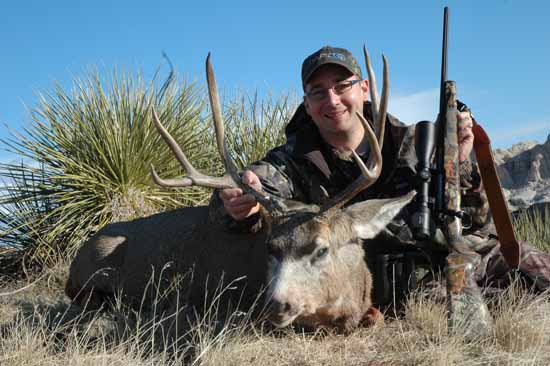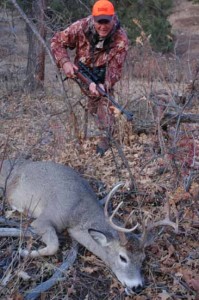
The solid “thwuck” of a bullet through front ribs is welcome music. A sharp “whock” means you struck big bone; a sodden, splashy, hollow landing means a paunch hit.
Always assume a hit. Always reload quickly. Excepting offhand shots up close in timber, I stay in shooting position for at least 10 seconds after a shot. If game appears after the shot, I make sure it is the same animal before firing again.

Always check if you suspect a miss. First, flag your shooting spot and the place where the animal was when you fired (I carry ribbon for this purpose). Many deer are lost because hunters don’t follow up intelligently after the shot. Blood may not appear on the trail for many yards, even if the damage is lethal. I’ve found dead deer and elk many yards from where they were hit and had to back-trail to see any blood. A bullet that doesn’t pass through may cause lots of internal hemorrhage, only to have elastic hide slip over the entry hole during escape, impeding leaks.
Once, after calling a good shot at a deer in open woodland, I watched it gallop off at an even and deliberate pace. I followed the hoofprints but found no blood. Returning to the site of the hit, I got down on hands and knees, searching in circles. A tiny pink pellet with a single deer hair caught my eye. Lung.
Carefully, I worked my way along the trail again. This time I found a drop of blood. At a turn in the trail, I spied a track I’d missed before. The buck lay a few steps farther on.
Game commonly makes an abrupt turn just before collapsing. A buck I hit too far back slipped into dense willows. I followed on hands and knees as the vegetation pressed in. There was no blood; it seemed as if the earth had swallowed this deer. Then I spotted a small gap to the side of what was now just a rabbit’s path. I crawled through it – and onto the carcass of the buck.
Perseverance is an asset. You might also call it a requisite. When you fire at big game, you have the responsibility to follow up. Some years ago, guiding a mule deer hunter, I spied a buck across a draw.
My client decided to shoot. The deer ran immediately. “Aw, I probably missed,” said the man, obviously not keen to cross the rugged draw and spend time on the deer’s trail. I insisted, though, and presently we stood where the animal had. “See, no blood.”
My companion wanted to start hunting again. I left him at the site and tracked the deer into timber, where I found it dead.
Lethal hits don’t always put game down immediately. In fact, most of the animals I’ve shot have moved before dropping. Regardless of the reaction, I always check and follow. As do all sportsmen.
Find Classic Sporting Rifles
 Retail: $24.99
Retail: $24.99
Your Price: $16.49
From Davy Crocket with “Old Betsy” to the mountain men and their Hawkens to the buffalo hunters and their Sharps and Winchester '73s – these are the rifles that fire the imagination. Gun Digest Presents Classic Sporting Rifles pays homage to these iconic guns with a wonderful compilation of articles written by a renowned panel of firearms writers of the 20th century.
Click here to order Gun Digest Presents Classic Sporting Rifles.

